Chicago (Notes-Bibliography) Citation Style Guide (17th ed.)
This piece of content has been developed by IvyPanda's editorial team.
No AI was involved in the creation process; only qualified experts contributed.
The information, facts, and sources presented in the text have been carefully checked and verified.
You are free to use it with proper referencing.
The Chicago style is generally used for scholarly books. It can seem complicated, as it requires you to provide a shortened version of the reference at the bottom of the page using a footnote. However, a simplified version that uses parenthetical references like most other styles also exists. This guide, written by experienced professionals who have worked with many formats, is here to help you understand and use both versions correctly.
This guide is developed in line with The Chicago Manual of Style, 17th ed. Chicago: University of Chicago Press, 2017.
- What is Chicago Citation Style?
- The Importance of Citing and Referencing
- General Principles of Chicago Style Formatting
- Chicago Book Citation
- Chicago Article Citation
- Chicago Dissertation and Thesis Citation
- Chicago Lecture Citation
- Chicago Website Citation
- Chicago Government Report Citation
- Chicago Secondary Sources Citation
- Tables and Figures in Chicago Style
What is Chicago Citation Style?
The Chicago style is mostly used for books and other long publications, where it is inconvenient to go to the end every time you want to check a reference. As such, it features a detailed reference to the source in a footnote at the bottom of the page, as well as the page number (if applicable). However, if you want to write a shorter paper using the format, there is an Author-Date version that functions in the same manner as APA and Harvard. The footnote-based variation is somewhat similar to Oxford due to its use of the same basic principles.
The Importance of Citing and Referencing
You may wonder why correct referencing is generally considered so important, taking precedence over most other aspects. Here are some reasons why this is usually the case, even in essays that may not seem so serious or important:
- Fundamentally, a person’s internal knowledge does not enable him or her to be at the forefront of research on his or her own. As such, references show that you know this and use others’ writings to help you.
- You show that your information comes from a source that can be considered trustworthy and unbiased by various scholars who read your work. Many readers will frown upon the use of data from websites unless they belong to large-scale agencies.
- To supplement this point, you have to format your references correctly due to the possibility that a wrongly formatted link will point to a nonexistent work. Referring to a fake work in the hopes that no one will check is a severe offense.
- Most organizations disapprove of plagiarism strongly, and citations are intended to prevent it. The practice can lead to consequences up to and including expulsion from whatever organization you write for and permanent reputation damage.
General Principles of Chicago Style Formatting
- Set 1″ (2.54 cm) margins on all sides.
- Use Times New Roman 12 pt. font (unless your instructions say otherwise).
- All words except for articles and prepositions should be capitalized in book / article / periodical titles.
- At the end of a paper written in compliance with the Chicago NB style, a full list of the sources cited in the paper appear in a separate section titled “Bibliography.”
- Bibliographical entries are single-spaced and separated by an additional line space.
Chicago Title Page
The title is placed almost in the center of the page and written in bold. Use a colon to separate the main title from the subtitle. The subtitle should be written below the title line.
Student’s name, tutor’s name (if required), course information, and date, are located in the lower part of the page, written in sentence case.
There should be no page numbers on the title page or page with the table of contents/outline.
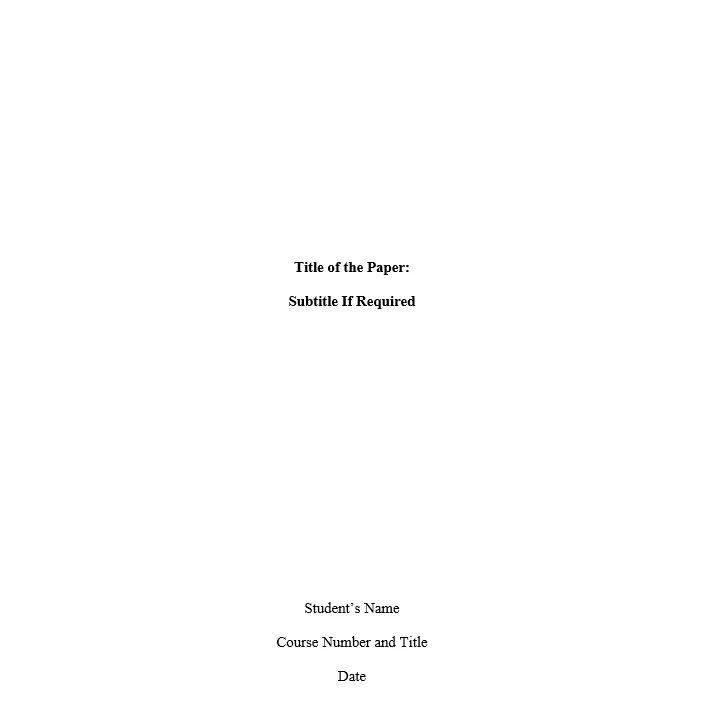
Chicago (Notes-Bibliography) Outline
Usually, a table of contents is used in Chicago NB papers. There is also a variant of an outline for you to use (unless your tutor gives you a template)
Example of a table of contents
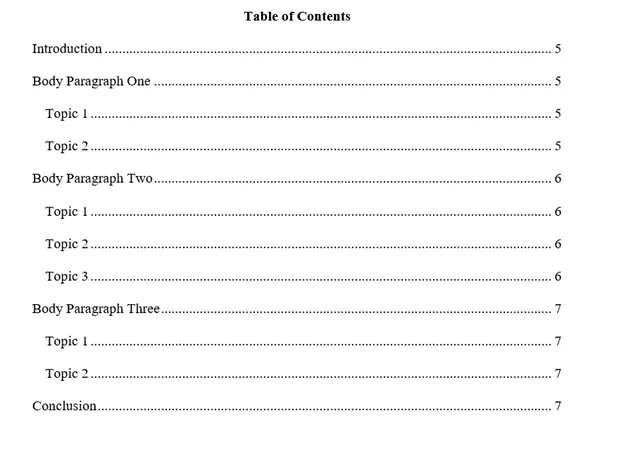
Example of an outline
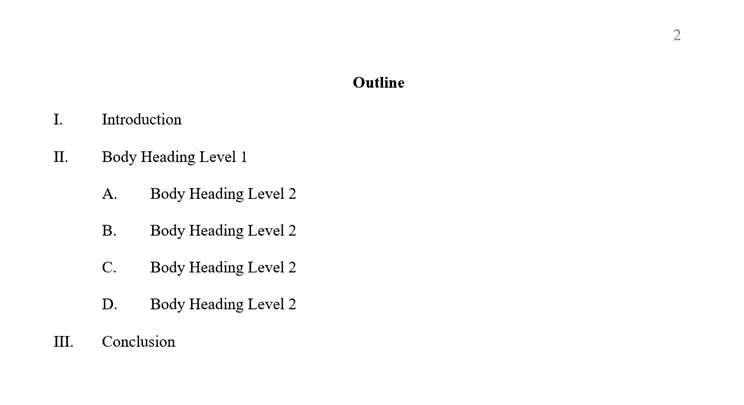
Chicago Headings and Subheadings
Level 1: Centered, Bold, Each Word is Capitalized
Level 2: Centered, Italicized, Capitalized
Level 3: Flush Left, Bold, Capitalized
Level 4: Flush left, regular font, sentence case
Level 5: Placed at the beginning of the paragraph. Can be italicized or bold, sentence case. A period is used to separate the subheading and the rest of the text in the paragraph.
Chicago Footnotes
- A footnote should be created every time you use a source.
- Footnotes appear at the bottom (footer) part of a page.
- A footnote should be indented (left margin).
- All succeeding lines of this footnote should be formatted flush left.
- Chicago footnotes are single-spaced and separated by an additional line space.
- The first footnote for one source should present all the information related to this source (including the author’s full name, title of the source, and other relevant facts).
- If the source is cited more than once, subsequent footnotes should only include the last name of the author, a short title (if the original title consists of more than four words), and the number(s) of the cited page(s).
- Note that the page number is required in all short-form citations, even if it is the same as the previous entry.
1. Firstname Lastname, Title of Book (Place of publication: Publisher, Year of publication), page number.
2. Lastname, Shortened Title of Book, page number.
The use of ibid. is now discouraged in favor of shortened citations as per the 17th edition of CMOS (section 14.34). In footnotes citing the same source as the one preceding, use a shortened form of the citation, as in note 1 below. The title of the work may also be omitted if the previous note includes the title, as in note 2 below.
1. Harvey, “Modernity and Modernism,” 12.
2. Harvey, 13.
Aside from ibid., Chicago style offers cross-referencing for multiple notes with repeated content (especially for longer, discursive notes). Remember: a note number should never appear out of order.
1. Michel Foucault, “The Means of Correct Training” in The Foucault Reader, ed. Paul Rabinow (New York: Pantheon, 2023), 188.
2. See note 1 above.
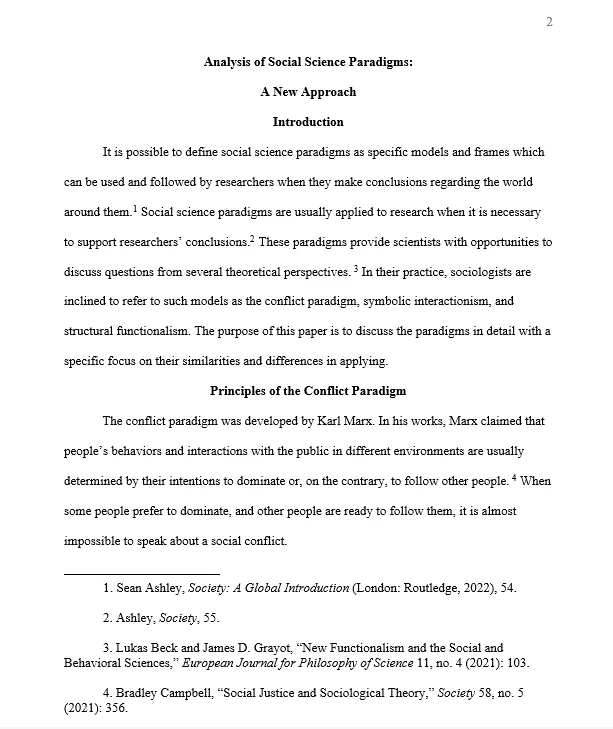
Chicago Bibliography
Bibliography is inserted at the end of your paper; any source that you use needs to be included in the bibliography section and cited in the text.
- Indent all lines after the first line in the entry (hanging indent); the lines should be indented one-half inch (1.27 cm) from the left margin of your paper.
- Invert authors’ names: Last Name, First Name.
Example: Clifton, Lucille. - The reference list is always alphabetized by the first word in the reference entry (from A to Z).
- When alphabetizing titles or group names as authors, go by the first significant word (disregard a, an, the)
- Capiltalize all words except for articles and prepositions.
- Italicization is applied to books and periodical journals’ titles.
- Double quotation marks are used for the titles of articles and book chapters.
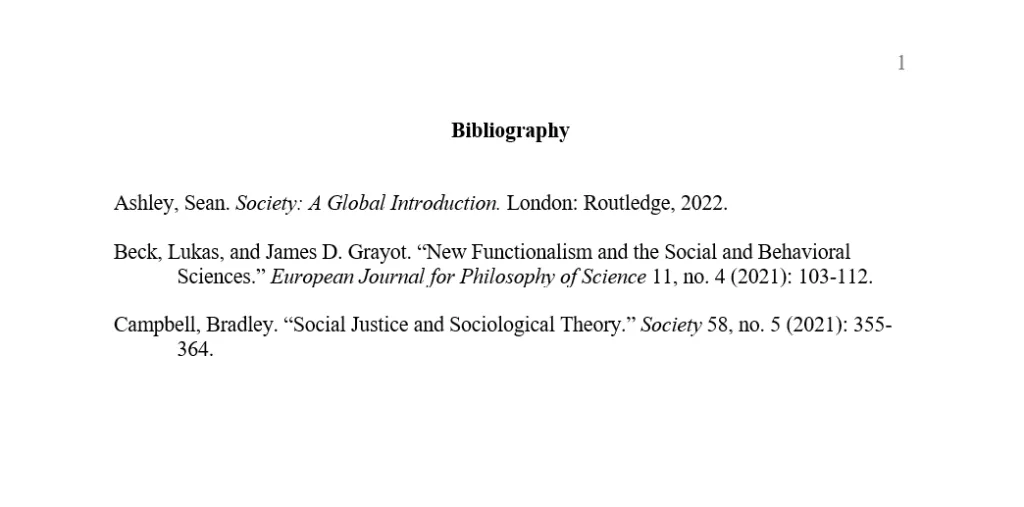
Chicago Bibliography Remark
If citing sacred texts, such as the Jewish or Christian scriptures, remember that they are usually mentioned in parenthetical citations or notes rather than in bibliographies. Such citations include book (in roman and usually abbreviated), chapter, and verse. A colon is used between chapter and verse. The traditional abbreviations use periods, but the shorter forms do not.
Traditional abbreviations:
4. 1 Thess. 4:11, 5:2–5, 5:14.
5. Heb. 13:8, 13:12.
6. Gen. 25:19–36:43.
Shorter abbreviations:
7. 2 Sm 11:1–17, 11:26–27; 1 Chr 10:13–14.
8. Jo 5:9–12; Mt 26:2–5.
Chicago Book Citation
Single author
Bibliography:
Last Name, First Name. Title of Book. Place of publication: Publisher, Year of publication.
Whitaker, Todd. What Great Teachers Do Differently: Nineteen Things That Matter Most. New York: Routledge, 2020.
Footnote citation:
1.First Name Last Name, Title of Book (Place of publication: Publisher, Year of publication), page number.
1. Todd Whitaker, What Great Teachers Do Differently: Nineteen Things That Matter Most (New York: Routledge, 2020), 33.
- If the city of publication may be unknown to readers or may be confused with another city of the same name, the abbreviation of the state, province, or (sometimes) country is usually added. Washington is traditionally followed by DC, but other major cities, such as Los Angeles and Baltimore, need no state abbreviation. (For countries not easily abbreviated, spell out the name.) When the publisher’s name includes the state name, the abbreviation is not needed.
- In notes and bibliography, an initial The is omitted from a publisher’s name, as are such abbreviations as Inc., Ltd., or S.A. following a name. Co., & Co., Publishing Co., and the like are also omitted. Books is usually retained (Basic Books, Riverhead Books). The word Press can sometimes be omitted (for example, Pergamon Press and Ecco Press can be abbreviated to Pergamon and Ecco, but Free Press and New Press—whose names might be confusing without Press—must be given in full). Press should not be omitted from the name of a university press because the university itself may issue publications independent of its press. The word University may be abbreviated to Univ. if done consistently.
Houghton Mifflin not Houghton Mifflin Co.
Little, Brown not Little, Brown & Co.
Macmillan not Macmillan Publishing Co.
Two or three authors
Bibliography:
Last Name, First Name, First Name Last Name, and First Name Last Name. Title of Book. Place of publication: Publisher, Year of publication.
Killen, Roy, and Mitch O’Toole. Effective Teaching Strategies. Melbourne: Cengage AU, 2023.
Footnote citation:
1. First Name Last Name, First Name Last Name, and First Name Last Name, Title of Book (Place of publication: Publisher, Year of publication), page number.
1. Roy Killen and Mitch O’Toole, Effective Teaching Strategies (Melbourne: Cengage AU, 2023), 12-17.
Four or more authors
Bibliography:
Last Name, First Name, First Name Last Name, First Name Last Name, and First Name Last Name. Title of Book. Place of publication: Publisher, Year of publication.
Bell, Michael, David Bush, Peter Nicholson, Dan O’Brien, and Thomas Tran. Universities Online: A Survey of Online Education and Services in Australia. Canberra: Department of Education, Science and Training, 2024.
Footnote citation:
1. First Name Last Name et al., Title of Book (Place of publication: Publisher, Year of publication), page number.
1. Michael Bell et al., Universities Online: A Survey of Online Education and Services in Australia (Canberra: Department of Education, Science and Training, 2024), 33–55.
No author
If there are no authors or editors in the source, then cite the source by title. In footnotes and corresponding bibliographical entries, citations should begin with the title, omitting the element with the first name and last name. The citation looks like this:
Bibliography:
Title of Book. Place of publication: Publisher, Year of publication.
Mythology: Myths, Legends and Fantasies. Croydon: Aurora Metro Books, 2023.
Footnote citation:
1. Title of Book (Place of publication: Publisher, Year of publication), page number.
1. Mythology: Myths, Legends and Fantasies (Croydon: Aurora Metro Books, 2023), 24.
Multiple works by the same author
Using multiple works by the same author poses no challenge as all are to be cited in footnotes at the bottom of the page.
Fromm, Erich. The Anatomy of Human Destructiveness. Harmondsworth: Penguin Books, 2021.
—. The Fear of Freedom. London: Routledge & Kegan Paul, 2023
Footnote citation:
1. Erich Fromm, The Fear of Freedom (London: Routledge & Kegan Paul, 2023), 33.
2. Erich Fromm, The Anatomy of Human Destructiveness (Harmondsworth: Penguin Books, 2021), 42.
Different editions
Bibliography:
Last Name, First Name, and First Name Last Name. Title of Book. # ed. Place of publication: Publisher, Year of publication.
Kremer, John, Aidan Moran, and Ciaran J. Kearney. Pure Sport: Sport Psychology in Action. 3rd ed. New York: Routledge, 2020.
Footnote citation:
1. First Name Last Name and First Name Last Name, Title of Book, # ed. (Place of publication: Publisher, Year of publication), page number.
1. John Kremer, Aidan Moran, and Ciaran J. Kearney, Pure Sport: Sport Psychology in Action, 3rd ed. (New York: Routledge, 2020), 104. [/citation_1_25_rev]
It may be required to further specify the place of publication. For example, “Hove, East Sussex”. In most cases, it would be sufficient to simply list the city.
Editor or translator instead of author
Bibliography:
Editor’s Last Name, First Name, ed. Title of Book. Place of publication: Publisher, Year of publication.
Helms, Marilyn M., ed. Encyclopedia of Management. 5th ed. Farmington Hills: Thomson, 2021.
Footnote citation:
1. Editor’s First Name Last Name, ed. Title of Book (Place of publication: Publisher, Year of publication), page number.
1. Marilyn M. Helms, ed., Encyclopedia of Management, 5th ed. (Farmington Hills: Thomson, 2021), 202.
In a case with a translator, use trans. instead of ed.
Authors plus editors or translators
Bibliography:
Last Name, First Name, and First Name Last Name. Title of Book. Edited by Editor’s First Name Last Name. Place of publication: Publisher, Year of publication.
Burns, Paul. Entrepreneurship and Small Business. Edited by Isabelle Cheng. London: Bloomsbury Publishing, 2022.
Footnote citation:
1. First Name Last Name and First Name Last Name.Title of Book, ed. Editor’s First Name Last Name (Place of publication: Publisher, Year of publication), page number.
1. Paul Burns, Entrepreneurship and Small Business, ed. Isabelle Cheng (London: Bloomsbury Publishing, 2022), 31.
Use phrases like edited by (ed.), compiled by (comp.) or translated by (trans.) when it is necessary.
Corporate author
Bibliography:
Organization Name. Title of Book. Place of publication: Publisher, Year of publication.
OECD. OECD Development Pathways: Multi-Dimensional Review of El Salvador. Paris: OECD Development Centre Publishing, 2023.
Footnote citation:
1. Organization Name.Title of Book (Place of publication: Publisher, Year of publication), page number.
1. OECD. OECD Development Pathways: Multi-Dimensional Review of El Salvador (Paris: OECD Development Centre Publishing, 2023), 4-8.
Encyclopedia or dictionary
If there is a need to cite the encyclopedia multiple times on the same page, use s.vv. instead of s.v., and cite all the words after (sub verbo, “under the word”; pl. s.vv.).
Bibliography:
Title of Encyclopedia. # ed. s.v. “Chapter Title”. Accessed Month Date, Year. URL.
Encyclopaedia Britannica Online. 15th ed. s.v. “Astronomy.” Accessed April 4, 2024. http://academic.eb.com/EBchecked/topic/6005638/Astronomy.
Footnote citation:
1. Title of Encyclopedia, # ed., s.v. “Chapter Title,” accessed Month Date, Year, URL.
1. Encyclopaedia Britannica Online, 15th ed., s.v. “Astronomy,” accessed April 4, 2024, http://academic.eb.com/EBchecked/topic/6005638/Astronomy.
Since all words in a dictionary or encyclopedia are typically placed in alphabetical order, no page numbers are necessary for print versions. However, the words must also be arranged in alphabetical order.
Chapter in an edited book
Bibliography:
Author’s Last Name, First Name. “Chapter Title.” In Title of Book, edited by Editor’s First Name Last Name, pages. Place of publication: Publisher, Year of publication.
Higgs, Malcolm. “Change and Its Leadership: The Role of Positive Emotions.” In The Oxford Handbook of Positive Psychology and Work, edited by P. Alex Linley, Susan Harrington, and Nicola Garcea, 67–94. New York: Oxford University Press, 2023.
Footnote citation:
1. Author’s First Name Last Name, “Chapter Title,” in Title of Book, ed. Editor’s First Name Last Name (Place of publication: Publisher, Year of publication), page number.
1. Malcolm Higgs, “Change and Its Leadership: The Role of Positive Emotions,” in The Oxford Handbook of Positive Psychology and Work, ed. P. Alex Linley, Susan Harrington, and Nicola Garcea (New York: Oxford University Press, 2023), 67–72.
Chapter in a single-author book
Bibliography:
Author’s Last Name, First Name. “Chapter Title” In Title of Book, pages. Place of publication: Publisher, Year of publication.
Anderson, Michael Alan. “Antiphons.” In Music and Performance in the Book of Hours, 20-31. London: Taylor & Francis, 2022.
Footnote citation:
1. Author’s First Name Last Name, “Chapter Title”, in Title of Book (Place of publication: Publisher, Year of publication), page number.
1. Michael Alan Anderson, “Antiphons,” in Music and Performance in the Book of Hours (London: Taylor & Francis, 2022), 23-24.
E-book
Bibliography:
Last Name, First Name. Title of Book. Place of publication: Publisher, Year of publication. Medium/E-Library/URL.
Austen, Jane. Pride and Prejudice. New York: Penguin Classics, 2024. Kindle.
Borel, Brooke. The Chicago Guide to Fact-Checking. Chicago: University of Chicago Press, 2016. ProQuest Ebrary.
Chan, Mimi. All the King’s Women. Hong Kong: Hong Kong University Press, 2024. EPUB.
Melville, Herman. Moby-Dick; or, The Whale. New York: Harper & Brothers, 1851. http://mel.hofstra.edu/moby-dick-the-whale-proofs.html.
Footnote citations:
1. First Name Last Name. Title of Book (Place of publication: Publisher, Year of publication), chap. #/page, Medium/E-Library/URL.
1. Jane Austen, Pride and Prejudice (New York: Penguin Classics, 2024), chap. 3, Kindle.
2. Mimi Chan, All the King’s Women (Hong Kong: Hong Kong University Press, 2024), chap. 4, EPUB.
3. Brooke Borel, The Chicago Guide to Fact-Checking (Chicago: University of Chicago Press, 2024), 92, ProQuest Ebrary.
4. Herman Melville, Moby-Dick; or, The Whale (New York: Harper & Brothers, 1851), 627, http://mel.hofstra.edu/moby-dick-the-whale-proofs.html.
Including the format of the document is important, so it must be specified. The most common formats are PDF, EPUB, Kindle, Microsoft Reader, Dejavu, etc. Pages in electronic versions of a book may differ from the original printed version. You can use chapters or sections of the book as locators.
Book consulted online
Bibliography:
Last Name, First Name. Title of Book. Place of publication: Publisher, Year of publication. DOI/URL.
Antokoletz, Elliot. Musical Symbolism in the Operas of Debussy and Bartók. New York: Oxford University Press, 2024. https://doi.org/10.1093/acprof:oso/9780195365825.001.0001.
Footnote citation:
1. First Name Last Name. Title of Book (Place of publication: Publisher, Year of publication), DOI/URL.
1. Elliot Antokoletz, Musical Symbolism in the Operas of Debussy and Bartók (New York: Oxford University Press, 2024), https://doi.org/10.1093/acprof:oso/9780195365825.001.0001.
Alternatively, the URL may be included instead of a DOI.
Preface, foreword, afterword, or introduction
Bibliography:
Last Name, First Name. Preface / Foreword / Afterword / Introduction to Title of Book, by/edited by Editor’s First Name Last Name, pages. Place of publication: Publisher, Year of publication.
Gay, Ross. Foreword to The Book of Light, by Lucille Clifton, i-iv. Washington: Copper Canyon Press, 2023.
Footnote citation:
1. First Name Last Name, preface / foreword / afterword / introduction to Title of Book, by/ed. Editor’s First Name Last Name (Place of publication: Publisher, Year of publication), page.
1. Ross Gay, foreword to The Book of Light, by Lucille Clifton (Washington: Copper Canyon Press, 2023), ii.
Should the book have multiple publishers, it is not necessary to cite all of them. Include only the first one in both footnotes and bibliography.
Co-publishers
Bibliography:
Last Name, First Name. Title of Book. First Place of publication: First Publisher; Second Place of publication: Second Publisher, Year of publication.
Smith, John H. Management. New York: Routledge; London: Taylor & Francis, 2021.
Footnote citation:
1. First Name Last Name, Title of Book (First Place of publication: First Publisher; Second Place of publication: Second Publisher, Year of publication), page numbers.
1. John H. Smith, Management (New York: Routledge; London: Taylor & Francis, 2021), 15-18.
Chicago Article Citation
Journal article
Bibliography:
Last Name, First Name. “Article Title.” Title of Periodical volume, no. # (Year): pages.
Yasmin, Hena, Salman Khalil, and Ramsha Mazhar. “COVID 19: Stress Management among Students and Its Impact on Their Effective Learning.” International Technology and Education Journal 4, no. 2 (2020): 65-74.
Footnote citation:
1. First Name Last Name, “Article Title,” Title of Periodical volume, no. # (Year): page.
1. Hena Yasmin, Salman Khalil, and Ramsha Mazhar, “COVID 19: Stress Management among Students and Its Impact on Their Effective Learning,” International Technology and Education Journal 4, no. 2 (2020): 69.
When a journal uses issue numbers only, without volume numbers, a comma follows the journal title.
Ali, Imran, and Omar ML Alharbi. “COVID-19: Disease, Management, Treatment, and Social Impact.” Science of the Total Environment, no. 728 (2020): 4-18.
Nguyen, Minh-Hoang, Tam-Tri Le, and Quan-Hoang Vuong. “Ecomindsponge: A Novel Perspective on Human Psychology and Behavior in the Ecosystem.” Urban Science 7, no. 1 (February 2023): 31-34.
International Journal of Management 14:20–29
International Journal of Management, no. 25, 90–117.
Journal articles with more than four authors
Journal articles often list many authors. If there are four or more authors, list up to ten in the bibliography. In notes, list only the first, followed by “et al.” (“and others”). For more than ten authors, list the first seven in the bibliography, followed by “et al”.
Bibliography:
Last Name, First Name, First Name Last Name, First Name Last Name, First Name Last Name, First Name Last Name, First Name Last Name, First Name Last Name, First Name Last Name, First Name Last Name, and First Name Last Name. “Article Title.” Title of Periodical volume, no. # (Year): pages.
Last Name, First Name, First Name Last Name, First Name Last Name, First Name Last Name, First Name Last Name, First Name Last Name, First Name Last Name, et al. “Article Title.” Title of Periodical volume, no. # (Year): pages.
Di Crosta, Adolfo, Irene Ceccato, Daniela Marchetti, Pasquale La Malva, Roberta Maiella, Loreta Cannito, and Mario Cipi. “Psychological Factors and Consumer Behavior During the COVID-19 Pandemic.” PloS One 16, no. 8 (2021): 4-18. https://doi.org/10.1371/journal.pone.0256095.
Footnote citation:
1. First Name Last Name, “Article Title”, Title of Periodical volume, no. # (Year): page. [/citation_1_25_rev]
1. Adolfo Di Crosta et al., “Psychological Factors and Consumer Behavior During the COVID-19 Pandemic,” PloS One 16, no. 8 (2021): 5, https://doi.org/10.1371/journal.pone.0256095.
You may indicate the month/season of publication in addition to the year, if available.
Journal article (no author)
Bibliography:
“Article Title.” Title of Periodical volume, no. # (Year): pages.
“Teacher Certification and Teacher Commitment.” International Journal of Scientific Research and Management 5, no. 11 (2023): 35–45.
Footnote citation:
1. “Article Title,” Title of Periodical volume, no. # (Year): page.[/citation_1_25_rev]
1. “Teacher Certification and Teacher Commitment,” International Journal of Scientific Research and Management 5, no. 11 (2023): 36, 38. [/citation_1_25_rev]
Newspaper article
Page numbers, if any, can be cited in a note but are omitted from a bibliography entry.
Bibliography:
Last Name, First Namel. “Article Title.” Title of Periodical, Month Date, Year.
Chavkin, Sasha, Caitlin Gilbert, Anjali Tsui, and Anahad O’Connor. “As Obesity Rises, Big Food and Dietitians Push ‘Anti-Diet’ Advice.” The Washington Post, April 3, 2024.
Footnote citation:
1. First Name Last Name, “Article Title,” Title of Periodical, Month Date, Year, page.
1. Sasha Chavkin et al., “As Obesity Rises, Big Food and Dietitians Push ‘Anti-Diet’ Advice,” The Washington Post, April 3, 2024, 4.
Newspaper article (no author)
Bibliography:
Title of Periodical. “Article Title.” Month Date, Year.
Chicago Tribune. “Obesity Epidemic.” June 5, 2023.
Footnote citation:
1. “Article Title,” Title of Periodical, Month Date, Year, page.
1. “Obesity Epidemic,” Chicago Tribune, June 5, 2023, 6.
If an article is available online, add a URL at the end of the citation.
Journal article with DOI
Bibliography:
Last Name, First Name. “Article Title.” Title of Periodical volume, no. # (Year): pages. DOI.
Van Waeyenberg, Thomas, Riccardo Peccei, and Adelien Decramer. “Performance Management and Teacher Performance: The Role of Affective Organizational Commitment and Exhaustion.” The International Journal of Human Resource Management 33, no. 4 (2022): 623-646. https://doi.org/10.1080/09585192.2020.1754881.
Footnote citation:
1. First Name Last Name, “Article Title,” Title of Periodical volume, no. # (Year): page, DOI. [/citation_1_25_rev]
1. Thomas Van Waeyenberg, Riccardo Peccei, and Adelien Decramer, “Performance Management and Teacher Performance: The Role of Affective Organizational Commitment and Exhaustion,” The International Journal of Human Resource Management 33, no. 4 (2022): 625, https://doi.org/10.1080/09585192.2020.1754881.
If there is no DOI, it is acceptable to use the URL in order to link the article to your work. If you know both URL and DOI, always use the latter.
Journal article from a database
Bibliography:
Last Name, First Name. “Article Title.” Title of Periodical volume, no. # (Year): pages. DOI/URL/Database.
Brennan, Virginia. “Living History.” Journal of Health Care for the Poor and Underserved 34, no. 1 (2023): ix-x. Project MUSE.
Haas, Barbara. “Liquid History.” World Literature Today 94, no. 4 (Autumn 2020): 38-43. https://www.jstor.org/stable/10.7588/worllitetoda.94.4.0038.
Footnote citation:
1. First Name Last Name, “Article Title,” Title of Periodical volume, no. # (Year): page, DOI/URL/Database.
1. Virginia Brennan, “Living History,” Journal of Health Care for the Poor and Underserved 34, no. 1 (2023): ix, Project MUSE.
2. Barbara Haas, “Liquid History,” World Literature Today 94, no. 4 (Autumn 2020): 41, https://www.jstor.org/stable/10.7588/worllitetoda.94.4.0038.
If there is no author, start the citation with the title of the article.
Online newspaper article
If you consulted the article online, include a URL (or DOI, if available) or the name of the database.
Bibliography:
Last Name, First Name. “Article Title.” Title of Periodical, Month Date, Year. URL/E-Library.
Chavkin, Sasha, Caitlin Gilbert, Anjali Tsui, and Anahad O’Connor. “As Obesity Rises, Big Food and Dietitians Push ‘Anti-Diet’ Advice.” The Washington Post, April 3, 2024. https://www.washingtonpost.com/wellness/2024/04/03/diet-culture-nutrition-influencers-general-mills-processed-food/.
Footnote citation:
1. First Name Last Name, “Article Title,” Title of Periodical, Month Date, Year, URL/E-Library.
1. Sasha Chavkin et al., “As Obesity Rises, Big Food and Dietitians Push ‘Anti-Diet’ Advice,” The Washington Post, April 3, 2024, https://www.washingtonpost.com/wellness/2024/04/03/diet-culture-nutrition-influencers-general-mills-processed-food/.
Chicago Dissertation and Thesis Citation
Thesis or dissertation
Bibliography:
Last Name, First Name. “Dissertation Title.” Degree statement., University, Year.
French-Nelson, Kerri. “Bridging Support: Examining the Effectiveness of Online Peer Mentors in an Adult Learner Precollege Program.” PhD diss., Middle Tennessee State University, 2023.
Footnote citation:
1. First Name Last Name, “Dissertation Title” (Degree statement., University, Year), page.
1. Kerri French-Nelson, “Bridging Support: Examining the Effectiveness of Online Peer Mentors in an Adult Learner Precollege Program” (PhD diss., Middle Tennessee State University, 2023), 45-47.
Chicago Lecture Citation
Course materials
Bibliography:
Last Name, First Name. “Lecture Title.” Lecture, University, Place, Month Date, Year.
Jackson, Sean. “The Basics of Cloud Computing.” Lecture, the University of Virginia, Charlottesville, October 10, 2023.
Footnote citation:
1. First Name Last Name, “Lecture Title” (lecture, University, Place, Month Date, Year).
1. Sean Jackson, “The Basics of Cloud Computing” (lecture, the University of Virginia, Charlottesville, October 10, 2023).
Chicago Website Citation
Website
Bibliography:
Organization. “Page Title.” Website Title (website). Last modified Month Date, Year/Accessed Month Date, Year. URL.
CivicPlus Content Management System. “Home Page.” City of Ithaca (website). Accessed April 6, 2024. http://www.cityofithaca.org/.
Footnote citation:
1. “Page Title,” Website Title (website), Organization, last modified Month Date, Year/accessed Month Date, Year, URL.
1. “Home Page,” City of Ithaca (website), CivicPlus Content Management System, accessed April 6, 2024, http://www.cityofithaca.org/.
- If the organization name and website name are the same, use the organization name.
- The word “website” may be added in brackets after the website name (if the type of the source is unclear).
- For web sources, include the date of access or the date of last modification.
Web page (no date)
Bibliography:
Last Name, First Name. “Page Title.” Website Title. Accessed Month Date, Year. URL.
Carpenter, John. “Alternative Cancer Treatments for Stage I, II and III Cancer Patients.” Cancer Tutor. Accessed January 25, 2024. https://www.cancertutor.com/ruleofthumb/.
Footnote citation:
1. First Name Last Name, “Page Title,” Website Title, accessed Month Date, Year, URL.
1. John Carpenter, “Alternative Cancer Treatments for Stage I, II and III Cancer Patients,” Cancer Tutor, accessed January 25, 2024, https://www.cancertutor.com/ruleofthumb/.
Image
Bibliography:
Last Name, First Name (if available). “Image Title.” Digital image. Website Title (website). Accessed Month Date, Year. URL.
“Tesla Autopilot Function.” Digital image. Wired (website). Accessed January 25, 2024. https://assets.wired.com/photos/w_860/wp-content/uploads/2017/01/Telsa_Autopilot_TA.jpg.
Footnote citation:
1. First Name Last Name (if available), Image Title, digital image. Website Title (website), accessed Month Date, Year, URL. [/citation_1_25_rev]
1. “Tesla Autopilot Function,” digital image, Wired (website), accessed January 25, 2024, https://assets.wired.com/photos/w_860/wp-content/uploads/2017/01/Telsa_Autopilot_TA.jpg.
Blog
Bibliography:
Last Name, First Name. “Blog Post Title.” Website Title (blog), Month Date, Year. URL.
Mosunic, Chris. “Why Is Anxiety More Common in Women? Plus, 8 Tips to Cope.” Calm (blog), March 25, 2024. https://www.calm.com/blog/women-anxiety.
Footnote citation:
1. First Name Last Name, “Blog Post Title,” Website Title (blog), Month Date, Year, URL. [/citation_1_25_rev]
1. Chris Mosunic, “Why Is Anxiety More Common in Women? Plus, 8 Tips to Cope,” Calm (blog), March 25, 2024, https://www.calm.com/blog/women-anxiety.
Titles of blogs should be set in italics.
Films and video recordings
Bibliography:
Last Name, First Name, dir. Film Title. Place of production: Distribution Company, Year. Medium.
Fabian, Anthony, dir. Mrs. Harris Goes to Paris. New York: Focus Features, 2022. DVD.
Footnote citation:
1. Film Title, directed by First Name Last Name (Place of production: Distribution Company, Year), Medium.
1. Mrs. Harris Goes to Paris, directed by Anthony Fabian (New York: Focus Features, 2022), DVD.
YouTube video
Bibliography:
“Video Title.” YouTube video, Length. Posted by Name. Month Date, Year. URL.
“Learn Accounting in Under 5 Hours.” YouTube video, 4:50:58. Posted by Accounting Stuff. September 20, 2021. https://www.youtube.com/watch?v=gPBhGkBN30s.
Footnote citation:
1. “Video Title,” YouTube video, Length, posted by Name, Month Date, Year. URL.
1. “Learn Accounting in Under 5 Hours,” YouTube video, 4:50:58, posted by Accounting Stuff, September 20, 2021, https://www.youtube.com/watch?v=gPBhGkBN30s.
Chicago Government Report Citation
Government report
Bibliography:
Organization Name. Government Report Title. Edited by First Name Last Name. City: Publisher, Year.
United Nations Department of Economic. World Social Report 2021: Reconsidering Rural Development. Edited by Mary Lee Kortes. Geneva: United Nations, 2021.
Footnote citation:
1. Organization Name, Government Report Title, ed. First Name Last Name (City: Publisher, Year), page.
1. United Nations Department of Economic, World Social Report 2021: Reconsidering Rural Development, ed. Mary Lee Kortes (Geneva: United Nations, 2021), 112-118.
Chicago Secondary Sources Citation
Personal communication
Footnote citation:
1. First Name Last Name, e-mail message, Month Date, Year.
1. Jared Smith, e-mail message, July 4, 2023.
Personal communications, including email and text messages and direct messages sent through social media, are usually cited in the text or in a note only; they are rarely included in a bibliography.
Books
No bibliographic citation is required.
Footnote citation:
1. First Name Last Name, Title of Book (Place of publication: Publisher, Year of publication), page number, quoted in First Name Last Name, Title of Book (Place of publication: Publisher, Year of publication), page number.
1. Jim Bean, A Book about Nothing, (New York: Elsevier, 2001), 37, quoted in Alexander Schultz, Modern Nihilism (London: Routledge, 2021), 5.
The 17th edition of Chicago Manual of Style discourages the use of secondary sources in academic research. It is to be avoided at all times. Should the original source not be available in any possible way, it is recommended to use the “quoted in” format for the footnote.
Tables and Figures in Chicago Style
The Chicago citation style demands that figures and tables are treated slightly differently, though overall, their use is similar. You should place both types of object in the paper’s body, between separate lines of text. However, while you are free to put tables wherever they are most appropriate, you have to present figures immediately after they have been mentioned for the first time (see figure 1).

Figure 1: Glass World.1
1. “Glass World,” digital image, EnvironmentalScience, accessed August 18, 2024, https://www.environmentalscience.org/wp-content/uploads/2016/09/NEPA-CEQA-640×425.jpeg.
You introduce a figure by inserting a footnote below, formatted the same way as though it is a standard footnote citation. With tables, you insert the table number and a short description of the contents above the object and add “Source:” with a footnote below. Note that both the title and the source line should be single-spaced, regardless of how you format the rest of the paper. Images are not mentioned in the Bibliography.
Chicago N-B Format Essay Examples
- A Christmas Carol of Dickens: Never Too Late for a Change of Heart
- Fahrenheit 451 by Ray Bradbury
- Hills Like White Elephants by Ernest Hemingway
- Into the Wild: Characters, Themes, Personal Opinion
- Invisible Man by Ralph Ellison
- Much Ado about Nothing by Shakespeare
- The Bluest Eye by Morrison: Characters, Themes, Personal Opinion
- The Coming of Age in Mississippi Memoir by Anne Moody
- The Outsiders by Susan Eloise Hinton